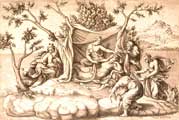For the Birth of Apollo.
As today is dedicated to the birth of Apollo, I am going to dedicate this blog entry to the Sun as understood by modern Astronomy.

The Layers of the Sun
Within Astrology, the Sun is the source of our health, energy, vitality and ego. The Sun in our charts is our fundamental life force, and the Sun is the fundamental life force of our Solar System. Enormous amounts of energy from the Sun - in the form of both sunlight and heat -support the base of the food chains that make life on Earth possible via photosynthesis. The same heat and light from the Sun also drive the Earth's climate and weather. Without the Sun to give light and to warm her, Gaea would be cold, dark, and lifeless.
It is interesting to note that the Sun does not have a definite boundary like the rocky planets do; there is no definite "surface" on the Sun like there is on the Moon or Earth. The Sun is a giant ball of glowing gas - much like a giant nuclear explosion. The Sun has an inside and outside however, as shown in the picture above; the outer layers decrease in density the further away from the center of the sun one moves, until one is in the corona region which is basically a cloud of super-fast (which means they are VERY HOT) atoms and particles. The corona is what is responsible for the beauty of the diamond ring effect and eerie glow that surrounds the darkened Solar Disk when one watches a Total Solar Eclipse. The Sun also puts out a "wind" of charged particles that blows through the Solar System and into space; this "wind" is what gives us the Aurora Borealis.
What is interesting to note is that the Sun is a Population I - or third generation star - who was born out of the powerful, explosive, shockwaves that came from one or more nearby supernovae. This is interesting because Apollo is a third generation God; the Olympians were the third generation of Gods to rule the Universe. First were the Forces, ruled by Gaea and Uranus, then the Titans ruled by Rhea and Kronos, then finally the Olympians, ruled by Zeus and Hera.
Even though the Sun is the nearest star to Earth, scientists still have a great many questions about the Sun that remain unanswered. Some current topics of scientific inquiry include:
- the Sun's regular cycle of sunspot activity,
- the physics and origin of flares and prominences,
- the magnetic interaction between the chromosphere and the corona,
- and the origin of the solar winds.









No comments:
Post a Comment